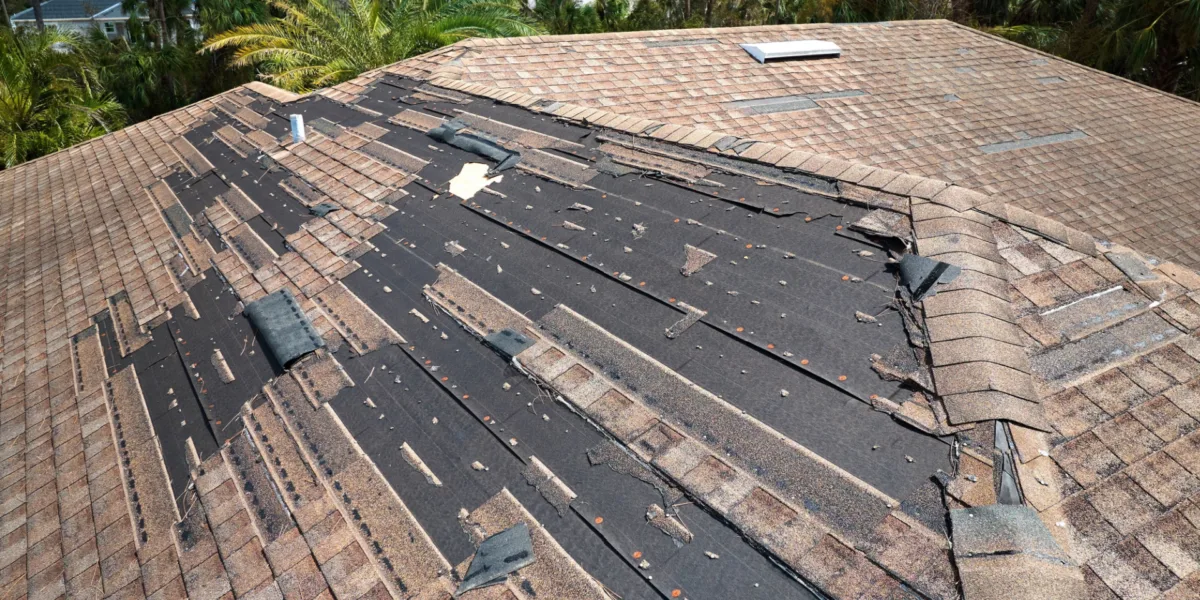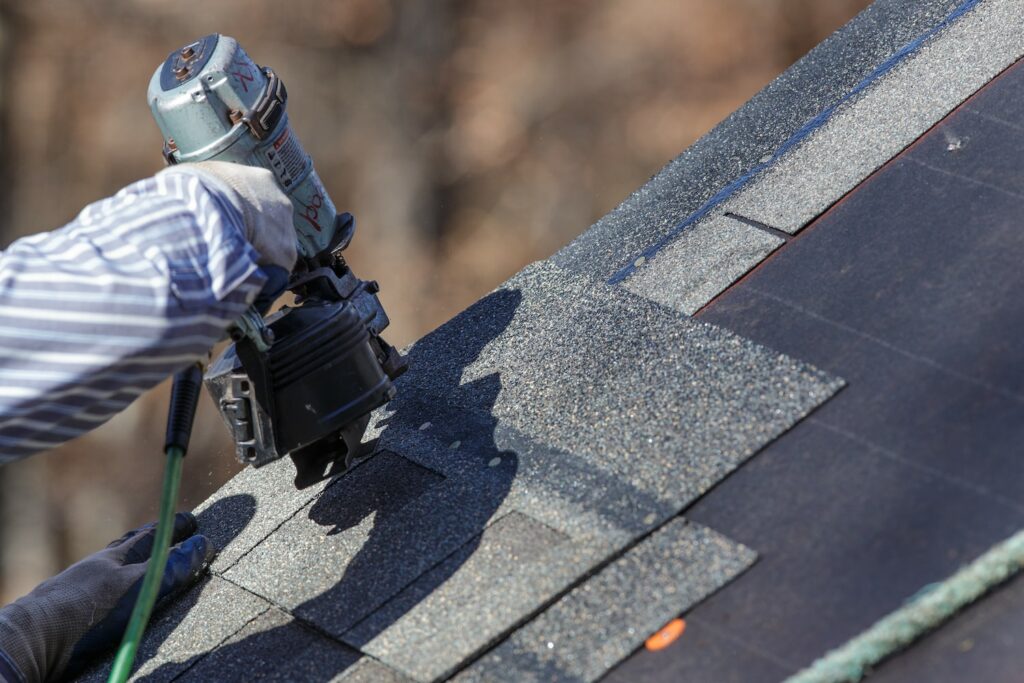DIY Roof Covering Repair Work: A Step-by-Step Overview to Dealing With Common Issues
You can tackle common roofing system concerns yourself by starting with a detailed examination for noticeable damages like missing shingles or sagging locations. Gather vital devices such as a tough ladder, roof hammer, and matching replacement tiles. Patch leakages by sealing flashing and replacing harmed tiles. Do not forget to keep rain gutters and guarantee water flows openly. Routine checks help prevent expensive repairs. If you prepare to read more about each action, there's plenty even more to discover!
 roof repair
roof repairAnalyzing Your Roof for Damage
Prior to you climb up onto your roofing, it's crucial to check it from the ground to recognize any noticeable indicators of damage. Look for missing out on tiles, curled sides, or staining that may indicate leaks.
Following, examine your gutters for granules from roof shingles or standing water, both of which can indicate roof covering issues. If you identify any kind of discolorations on ceilings or walls inside your home, these can be signs of water damage linked to your roof.
Do not forget to check out blinking around smokeshafts and vents, as damaged blinking can result in leakages. If you notice anything concerning, it's ideal to resolve it without delay to avoid more substantial repairs later. Always prioritize safety, and do not wait to call a professional if required.
Collecting the Required Tools and Products
Before you begin your roofing system repair, you require to gather the right devices and materials. Recognizing what essential tools you'll need, creating a list of required materials, and prioritizing safety equipment will establish you up for success. Let's look at what you'll need to tackle this task effectively and safely.
 roof repair
roof repairCrucial Tools Introduction
A strong roofing repair begins with the right devices and products at your side. To take on typical problems effectively, you'll require a couple of essential tools. Order a sturdy ladder to securely access your roof covering. A roofing hammer or a nail gun will assist you secure tiles or other materials. Don't forget an energy knife for reducing roofing products precisely.
Safety and security gear is vital also; a set of job handwear covers and security goggles will certainly safeguard you from sharp sides and debris. A measuring tape guarantees specific dimensions while a pry bar aids remove damaged tiles. With these devices in hand, you'll be prepared to manage different roof covering fixings with confidence.
Required Materials Checklist
With your devices ready, it's time to collect the materials needed for your roofing system fixing. Check your shingles. Get matching substitute shingles if they're harmed. You'll also need roof nails, a strong adhesive, and a sealer to assure everything keeps leak-proof. Don't fail to remember a tarpaulin or roof covering paper to secure exposed locations while you work. If you're taking care of leakages, consider purchasing a water-proof membrane also. For blinking repairs, buy new blinking products that fit your roof covering kind. Order a bucket or container for any debris you'll eliminate. Having all these materials available will certainly make your repair procedure smoother and extra efficient, so you can get the work done right.
Safety And Security Gear Value
While you might be passionate to start your roofing repair service, don't ignore the importance of safety and security gear. Wearing the ideal tools can protect against major injuries and ensure you function effectively. Begin with a sturdy headgear to protect your head from dropping debris. Non-slip shoes are essential for preserving grasp on the roof's surface. Don't fail to remember gloves; they'll maintain your hands safe from sharp devices and materials. Safety and security goggles will secure your eyes from dust and debris. A harness is a has to if your roof is high or high, stopping falls. A first-aid kit ought to constantly be on hand for minor injuries. Focusing on safety and security equipment sets you up for a successful and safe and secure fixing job.
Covering Roof Leakages
When you notice a leakage, the initial step is recognizing its resource to assure an efficient patch. As soon as you determine the trouble, you'll need to pick the best products for a long lasting repair. We'll walk you through the very best application strategies to seal those leakages and protect your home.
Determining Leakage Sources
Exactly how do you determine the source of a roof leakage? Start by evaluating your roofing for visible damage or wear. If it's risk-free, climb up to your roofing and aesthetically check for any kind of abnormalities.
Picking Spot Products
Picking the best patch products is important for efficiently repairing a roof leakage. For flat roof coverings, use a specialized patching product developed for that surface.
Always make specific the materials work with your existing roof covering to ensure a long-lasting repair. Examine the weather conditions; some products need cozy or dry temperature levels to stick effectively. Pick high-quality items to stay clear of regular repairs down the line. By picking the right products, you'll establish on your own up for an effective patching job.
Application Methods Clarified
Using spot materials properly is vital for securing roofing leakages and stopping more damage. Start by cleaning up the area around the leak, getting rid of any particles, dust, or loosened roof shingles. This assures a strong bond in between the patch and the roof surface area. Next off, reduce your spot material to fit over the harmed area, prolonging it a minimum of two inches past the sides of the leakage. Apply a generous layer of roofing sticky or sealer to the location, after that push the spot strongly right into area. Smooth out any type of air bubbles and confirm the edges are well secured. Ultimately, use an extra layer of sealant over the spot borders for added defense. Enable the patch to heal totally before exposing it to rain or extreme weather.
Changing Broken Tiles
When you observe harmed roof shingles on your roof covering, it's important to deal with the concern promptly to stop further leaks and architectural damages. Begin by gathering your devices: a pry bar, hammer, roofing nails, and substitute tiles that match your current ones. Initially, thoroughly lift the damaged roof shingles with your lever to remove it without disrupting the surrounding tiles. Once it's free, inspect the area beneath for any type of indicators of damages. If whatever looks excellent, move the brand-new tile right into area, aligning it with the others. Safeguard it with nails, making sure to adhere to the manufacturer's standards for positioning. Remember to cover the nail heads with a little roofing concrete to assure appropriate securing. Tip back and inspect your work to validate a seamless appearance. With these fast actions, you can efficiently change broken tiles and preserve your roofing's honesty.
Cleansing and Maintaining Rain Gutters
To keep your roofing system in leading condition, routinely cleaning and maintaining your gutters is crucial. Blocked rain gutters can lead to water damage, mold development, and also structural concerns.
Following, flush your seamless gutters with a garden pipe to guarantee water flows easily. Look for leaks or rust spots while you go to it. If you notice any kind of issues, think about applying a sealer or replacing damaged sections.
To prevent future blockages, mount rain gutter guards or get info displays, and make it a practice to clean your seamless gutters a minimum of two times a year, especially before heavy rainfall or snow. Normal upkeep not only extends the life of your gutters yet also shields your whole roof.
Securing Roofing Vents and Flashing
Sealing roof vents and blinking is important for stopping leakages and securing your home from water damages. Start by examining the locations around your roofing system vents and flashing for any type of spaces or cracks. Tidy the surfaces completely to guarantee proper adhesion if you discover any kind of. You'll desire to utilize a top quality roofing sealant or caulk made for exterior use.
Apply the sealant kindly, filling all gaps and cracks, after that smooth it out with your finger or a caulking tool for a neat coating. Make sure the sealant prolongs somewhat beyond the edges to develop a solid bond.
Permit the sealant to treat as per the maker's guidelines, usually a couple of hours or over night. After sealing, it's a good idea to inspect your job after a rainstorm to confirm everything stays leak-proof. Regular maintenance of your roof covering vents and blinking can conserve you from pricey repair work down the line.
Repairing and inspecting Roof covering Valleys
Roof covering valleys are essential locations where two inclines fulfill, and they play a vital function in routing water far from your home. To check your roof valleys, begin by climbing safely and trying to find indicators of damage like loosened roof shingles, fractures, or particles. Clear out any type of leaves or dirt that may block water circulation. If you see any kind of problems, you'll need to do something about it rapidly to stop leakages.
For minor repairs, replace harmed roof shingles and apply roofing cement to seal gaps. Taking care of roofing system valleys without delay will assist shield your home from water damages and prolong the life of your roofing system.
Regularly Asked Questions
If My Roof Covering Requirements Substitute Rather of Repair?, how Can I Determine.
To figure out if your roof needs replacement, look for considerable damages, drooping locations, or missing tiles. Think about replacement over repair service. if leaks continue despite fixings or it's nearing the end of its lifespan.
What Security Safety Measures Should I Take While Fixing My Roof Covering?
When fixing your roof, always put on a harness and non-slip shoes. Ensure your ladder's secure, avoid operating in negative weather condition, and have someone close by to help you in instance of emergency situations.
Just how Typically Should I Inspect My Roof for Damages?
You should examine your roofing system at the very least two times a year, preferably in spring and fall. After severe weather, look for damage as well. Regular inspections can help you capture issues before they develop into expensive fixings.
Can I Repair My Roof in Bad Climate Issues?
You should not try roofing fixings in bad weather. Rainfall, snow, or strong winds can increase risks and complicate the procedure. Wait for clear conditions to ensure your safety and security and accomplish a correct repair.
If I Encounter Wildlife in My Attic During Fixes?, what Should I Do.
If you come across wildlife in your attic room during repairs, stop quickly. Protect the area, stay clear of stunning the animals, and contact a specialist wildlife elimination solution to securely manage the scenario prior to proceeding your job.
Prior to you start your roof covering repair work, you need to gather the right devices and products.A strong roofing system repair begins with the right devices and materials at your side.With your tools all set, it's time to collect the materials required for your roof repair work.Selecting the best spot materials is essential for efficiently fixing a roof covering leakage. Taking treatment of roofing valleys immediately will assist safeguard your home from water damages and prolong the life of your roof covering.